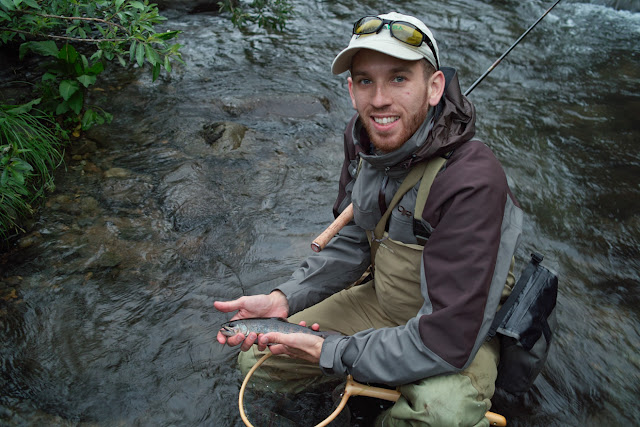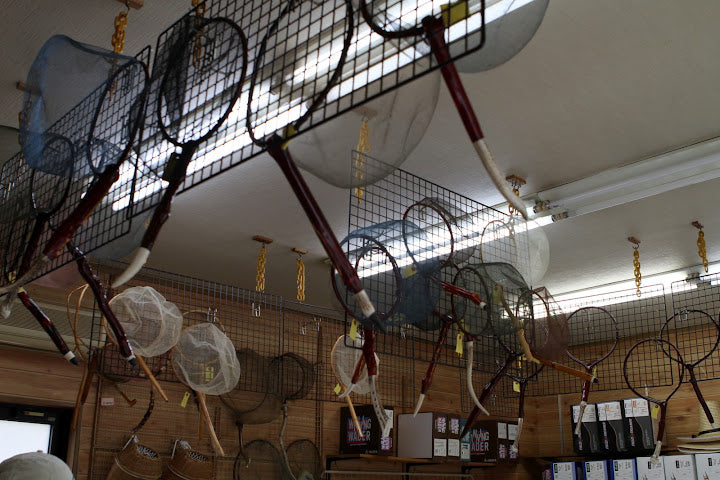I have absolutely fallen in love with Tenkara nets (tenkara tamo in Japanese). As I got to see many examples up close, and learn about how they are made, and about their design, I realized tenkara nets are just masterpieces of simple organic, yet functional design. Each net is a work of art and I'm surprised I haven't run across one at a museum somewhere. True, I haven't been this excited about something since I discovered tenkara rods.
One of the main reasons for their appeal is the fact that tenkara nets are made out of a single branch of a tree. How much simpler can it get? No carving, no manufacturing, a simple, organic, tree branch selected and used to make a strong, and functional net frame. Of course, simplicity doesn't always mean easy, and in this case it definitely does not. A good tenkara net is very hard to make, and it takes a long time to finish.
The process of making a real tenkara net starts with the selection of the wood; this is the most important step, and the defining one in the process. A tenkara net craftsman will spend days walking in the woods in search of the branches that will work well for making a net. He'll look for just the right branch with the right angles and diameters. After I learned how these nets are made, I have spent a lot of time looking up to trees, trying to identify those branches that may offer the right angles for a net, and they are really not easy to come by, at least not to the untrained eye. As a result, every single net will be a completely unique piece, with lots of effort put into each one.
Traditionally tenkara nets are made with branches from the kaya tree (Torreya nucifera), a relatively rare type of conifer tree found in southern Japan and an island in South Korea. The trees are a protected species; they are slow growing trees, confined to a small area; thus, any branches that are found are even more highly prized. While I believe many other trees may work, the kaya seems to be ideal for these nets, it's durable and hard yet lightweight, the wood has interesting patterns and a uniform grain. One of the nets I purchased, a slightly "large" one with a longer handle weighs a mere 3.5 oz. Occasionally bamboo is also used, though bamboo is not as durable for this application, and more difficult to work with, so makers tend to prefer wood branches.
In Gujo, Gifu prefecture, we visited a shop that specializes in tenkara nets. The store is run by the artisan and his wife and almost all nets are made by him. It is one of the few places in all of Japan that makes and carries thems. It's a wonderful display of unique and authentic tenkara nets, some simple and functional, some with unique wood features, and some featuring ornamental deer antlers, which are said to protect anglers in the water. Yes, I did feel like a "kid in a candy store".
The design and features of a tenkara net Tenkara nets are just perfectly designed, even though no one ever really designed one, and even though I'll suspect no tenkara net is never really "perfect". As a matter of fact, imperfections are more than welcome on the nets, there is no need for the frame to be perfectly leveled or for the wood to be free of "flaws". This may actually be their allure. The natural aspect of each branch is fully embraced by the maker, and by the angler. I think the concept of wabi-sabi applies well here. I have always been a big fan of Japanese design, and with so much inspiration from all aspects of life, even fishing, it's no wonder Japanese design tends to be so clean, and functional.
The round shape of the net comes from the way the nets are made. Essentially one gets a branch that is Y-shaped (normally a trident shape, where the middle branch is cut off), and through a process of drying and steaming the wood, as well as forcing it into shape, bends the net frame into a circle. The reason for a circle shape is simple, a circle is the strongest shape that can be made to receive pressure or hold weight. Thus, a good circle is also a good indicator of the quality of the net. The circular frame is the best shape to uniformly distribute the pressure a fish puts on the frame, as well as on the net mesh.
The angle between the net frame, and the handle, is also an important functional attribute. As I experienced, this angle is supposed to help in a few ways. When wearing a wading belt (or a regular belt for that matter) the angle keeps the mesh and frame off one's back, thus allowing the angler to move freely as he walks or climbs over a rock.

Click below for some very instructive web pages (in Japanese) on making the nets. A miniature tenkara net served as decoration in the net store, cute.
